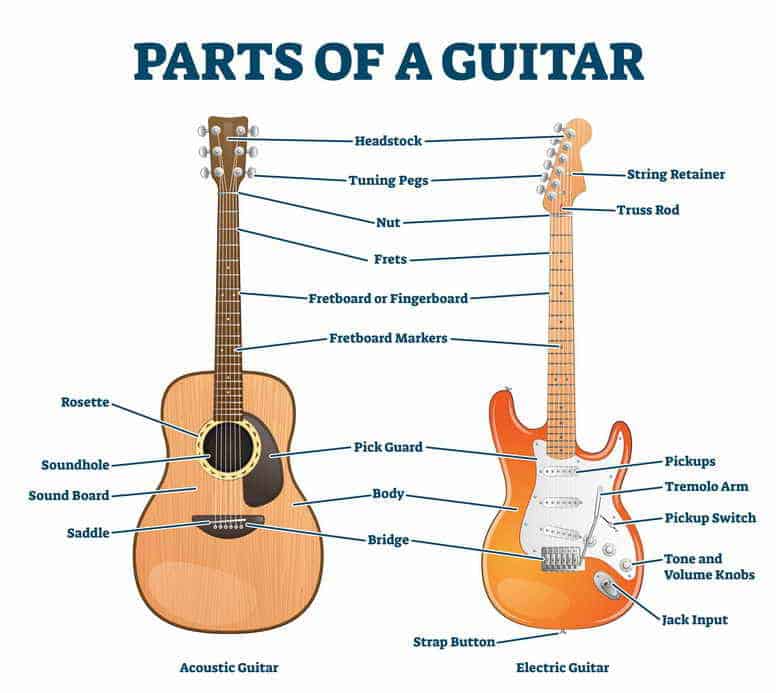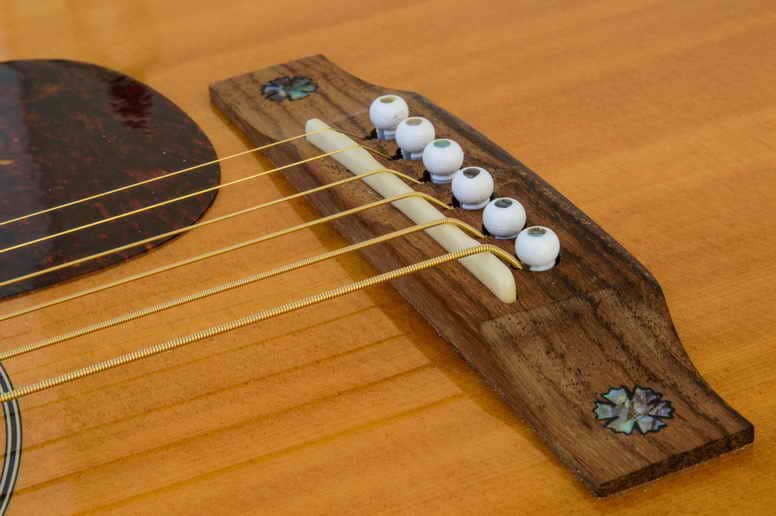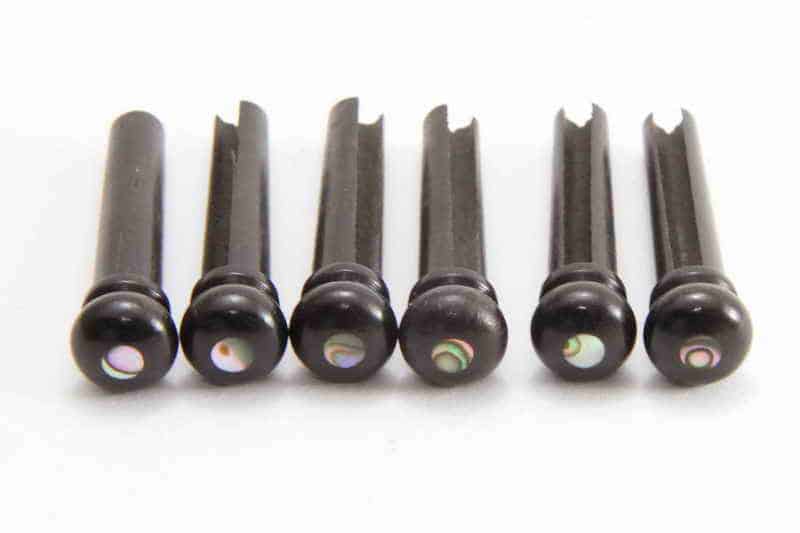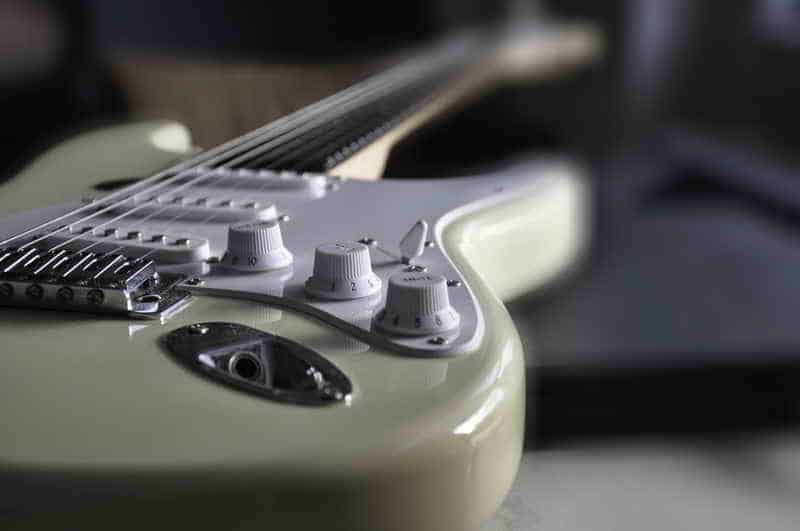Before buying or learning how to play any instrument or equipment, you need to familiarize yourself with the basic terminology associated with it and its anatomy. In this article, we will introduce you to the different parts of acoustic and electric guitars. Each of these types of guitars has three basic parts – the body, the neck, and the headstock.
These fundamental parts are further made up of different components. We will examine all of these guitar parts in detail in the coming sections.

Body
The body of the guitar is where you strum or fingerpick the strings. The design of the guitar body defines its tonal properties to a large extent. The body of an acoustic guitar is hollow and comprises a soundboard, known as the top, and its back and sides. It is designed to be played without amplification. The electric guitar body, on the other hand, can be solid, semi-hollow, or hollow.
Parts Of The Body Of The Acoustic Guitar
Bouts And The Waist
The acoustic guitar body is the biggest part of the guitar and is divided into the upper bout (towards the neck side), the waist, and the lower bout (on the bridge side). Bouts are measured by their widths, with the lower bout being, the larger of the two. The waist allows comfortable placement of the guitar on the knee of the guitarist performing in the seated position and plays a role in defining its tonal properties.
Acoustic guitars come with nylon or steel strings and in many body shapes, styles, and sizes. Generally, a bigger body means a bigger sound.
Soundboard Or The Top
Soundboard is the voice and soul of the instrument. Its vibration is responsible for the quality of sound and tone of the acoustic guitars. The below-listed factors have a profound impact on the quality, volume, sustain, and presence of the guitar sound.
- Choice of tonewood,
- Its seasoning and milling processes,
- Solid wood or laminate,
- String type,
- The tension of the strings
- The Bracing pattern
Sound Hole
It is a popular misconception that a sound hole is there to let the sound out. It actually releases the air pressure in the chamber, allowing the top to vibrate much more freely. Sound chambers with orifice are called Ported enclosures or Helmholtz resonators.
Some guitars may have the center of the sound hole slightly misaligned with the center of the waist called “offset soundholes” or have D-shaped, elliptical or triangular soundholes. This is usually done to accommodate modified bracing patterns or cutaways.
If all other related factors are equal, a larger soundhole provides better treble balance while a smaller one improves the low end.
Acoustic Bridge, Bridge Plate, And Pin
The bridge is the anchor point for the strings and transmits their vibrations to the soundboard of the guitar, which has a much larger resonant area to have a larger displacement of air. High-End acoustic guitars use bridges made from either Ebony or Rosewood. Less expensive guitars may use ebonized walnut, plastics, extruded nylon, or bone. Rosewood is preferred for Classical guitars.
The bridge on any quality acoustic guitar is glued directly to the bare wood instead of the finish. On some inexpensive guitars, the bridge may be bolted onto the soundboard. This, however, is an acoustically inferior arrangement.

A bridge plate is a flat brace made from a dense piece of wood, usually maple or rosewood that improves the strength and the acoustic transmission of the guitar. Once the steel string is inserted through the hole in the bridge pin, the ball pulls up against the bridge plate. Bridge pins are simply there to jam the balls under the bridge plate. The size and quality of bridge plates affect the balance, volume, and sustain of the instrument.
Ebony and Rosewood bridge pins sound better than plastic pins. Brass, ivory, and bones are other materials used to make these pins.

Saddle
A saddle is a strip of bone or other dense material placed in the groove of the bridge. It is usually made from the same materials as nuts. The strings rest on the saddle before they enter the pins. The saddle should be smoothly curved on its top, and else the sharp edges will cause string breakages. Flattop and classical guitar saddles should be without grooves, unlike the electric, archtop, or 12-string guitars.
Pick Guard
Part of the soundboard below the soundhole is prone to damage from the fingers and picks. A sheet of black or tortoiseshell celluloid is attached as protection. Thin pickguards are always better than big and heavy ones as they don’t bring any perceptible difference to the volume and tone of the instrument.
Strap Buttons
Strap buttons are metal studs that allow you to attach a strap to your guitar. Go in for strap locks as additional security if you find your guitar isn’t perfectly balanced.
Parts Of The Body Of The Electric Guitar
Pickups
Pickups are electromagnetic devices used on acoustic-electric and electric guitars to produce sound by converting the energy of vibrating strings to electric signals. The pickups usually have a bar magnet with thousands of coils of thin copper wire coils wrapped around it.
Different types of magnetic pickups include Contact pickup (microphones), Passive pickup, Active pickup, and Piezo-electric pickup (placed on bridges). On acoustic guitars, you can place the pickups in several locations.
Different pickups include single-coil pickups, humbucking pickups, split-coil pickups, etc. Single coil pickups produce a bright, crisp sound with better note definition, but are prone to hums.
Pickup Selector Switch
Electric guitars may have one, two, or three pickups. Their placement has a great influence on the sound of the guitar. With the pickup, closer to the bridge, the sound is bright and chimy and changes to warm and bassier, as the pickup is moved towards the neck.
It is possible to choose the type of sound you want, during playing, by selecting a pickup or a combination of pickups, out of the available ones. The pickup selector switch allows you to do that. Selector Switch can be a 3-way switch for 2 pickups or a 5-way switch for an electric guitar with 3 pickups (like Stratocaster).
Volume And Tone Knobs
These control circuits process the electrical signals produced by the pickups before passing them to the amplifiers. The circuits may have more than one volume and tone control knob. These knobs contain potentiometers to adjust the values.
The volume control makes the guitar sound soft or louder, while the tone knob works as a filter and allows you to control the level of high-frequency signals or the brightness of the tones. The first tone knob controls the neck pickup, while the second knob may control either the middle pickup alone or both middle and bridge pickup.

Whammy Bar
The whammy bar is used to change the pitch temporarily by altering the tension on all of the electric guitar strings at the same time. As each string has different tension, the change in pitch is different for each of the strings.
Parts Of A Guitar Neck
Neck
The neck connects the body of the guitar to its headstock. It acts as a base for the fingerboard where the frets are seated and carries the truss rod along its length. It is designed to withstand the tension of the strings, resist warping, and influence playability and tonality.
The shape of the neck may vary anywhere from the V shape to the C-Shape. They are connected to the body through a Dovetail joint or a Mortise & Tenon joint. In some instruments, the neck is simply bolted to the body.
Truss Rod
Relief is the intentional warp provided around the sixth fret to make the upper frets more playable. It was very difficult to carry out relief adjustments till the advent of the truss rods. With the introduction of steel-string guitars, warping under the string tension became a common issue. The function of the truss rod is to prevent warping and regulate the relief in the neck.
Fingerboard Or Fretboard
The fingerboard or fretboard (for fretted guitars) is the flat section of the wood placed above the neck of the guitar. The part of the fretboard in the body portion is called a Spatula or Fingerboard Extension. Common choices of wood for the fretboard are Ebony, Rosewood, Maple, or other hardwoods.
Most nylon-string guitars have a completely flat fretboard as these are more suited to classical playing. Steel-string guitars usually have a contoured fretboard. The fretboard surface may be cylindrical (constant radius of curvature from nut to bridge) or conical (varying radius of curvature that is larger at the bridge).
Frets
Frets are the raised metal strips running the full length of the fretboard against which the strings are pressed to produce the notes. Frets made from Nickel Silver are used on most top instruments. Other common choices for the fret materials are stainless steel and Evo. Inexpensive guitars may use brass.
Frets have two main parts – the crown and the tang. The crown is the exposed part of the fret, while the tang holds the fret onto the fretboard. The size and shape of these two components are changed in different types of guitars to cater to the playing preferences of the players.
Inlays
Inlays are the decorative markers on the fretboard to assist the players in seeing the position of their fretting fingers. These may be in the form of simple dots or complex and decorative designs.
Strings
Strings come in different materials, construction, and gauges for different types of guitars, lower or higher strings. They are made up of nylon for classical guitars, steel for electric guitars, and steel, brass, or bronze for acoustic guitars. Lower strings have a core with fine brass or bronze wire wrapped around them to increase their mass and are called wound strings. Higher strings have just the core.
Higher gauge strings exert more tension and require more force to press them against the fret. The heavier string will transmit more energy to the top of the guitar.
The Nut
The nut is located towards the headstock end of the neck. Different types of materials used for nuts is bone, ivory, ebony, metal, graphite, ceramics, epoxy resin products, hardwood, or plastic. The main functions of a nut are to support the crossing string, provide an anchor point for the vibrating length of the open strings, maintain equal spacing between all strings over the entire neck length, regulate string height above the fretboard, and define the scale length
Parts Of The Guitar Headstock
Headstock
The headstock is a flat section located at the top of the neck. Also known as the peghead, it is where the nut and tuning machines are mounted. The majority of steel-string guitars have a solid headstock with perpendicularly mounted pegs.
Many twelve-string guitars have a slotted peghead to look more appropriate visually. The shape and size of the headstock may vary among different manufacturers with trapezoid being the most common shape. They may be straight or angled. The standard guitar has 6 tuning machines, one for each string.
Three main headstock configurations in use for acoustic and electric guitars are 3 per side, inline and classical tuners. Three inline tuning machines are mounted on a common metal plate with one plate fixed on each side of the headstock
Tuners
Tuners are also known as tuning pegs, machine heads, and tuning machines. Tuning pegs tune the strings by rotating the capstan to wind or unwind the strings around it. This winding action through a pinion gear and worm gear tightens (tune-up) or loosens (tune-down) the string, thereby, increasing or decreasing the pitch. Capstans are cylinders with a hole through which the string is inserted.
Good Tuning machines should not have excessive play or slip and should be easy to work with. Machines with a higher gear ratio allow precise tuning to be achieved with much less effort. Many fancier versions are available with ornate knobs, gold plating, filigree, and chasing particularly at the higher price brackets.

